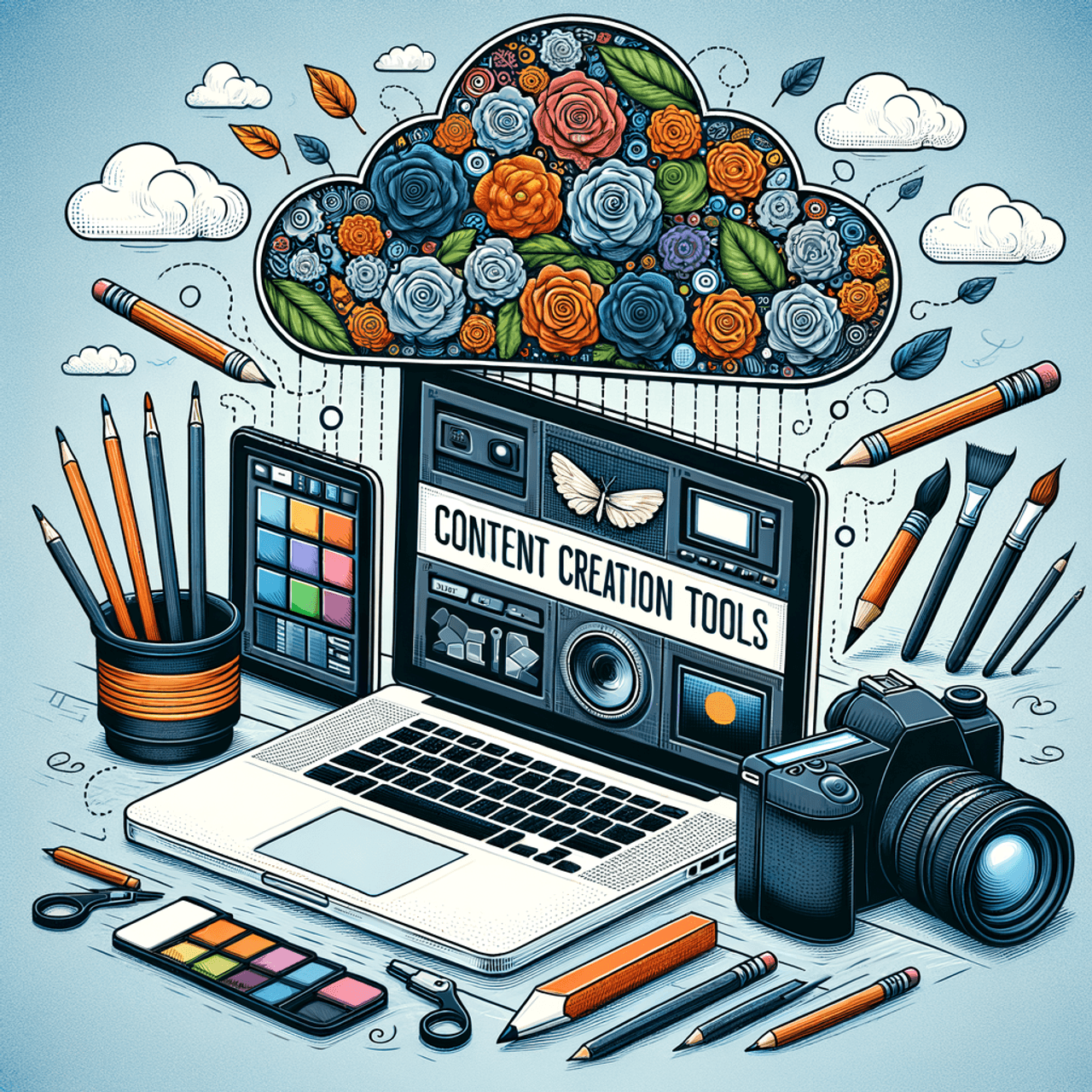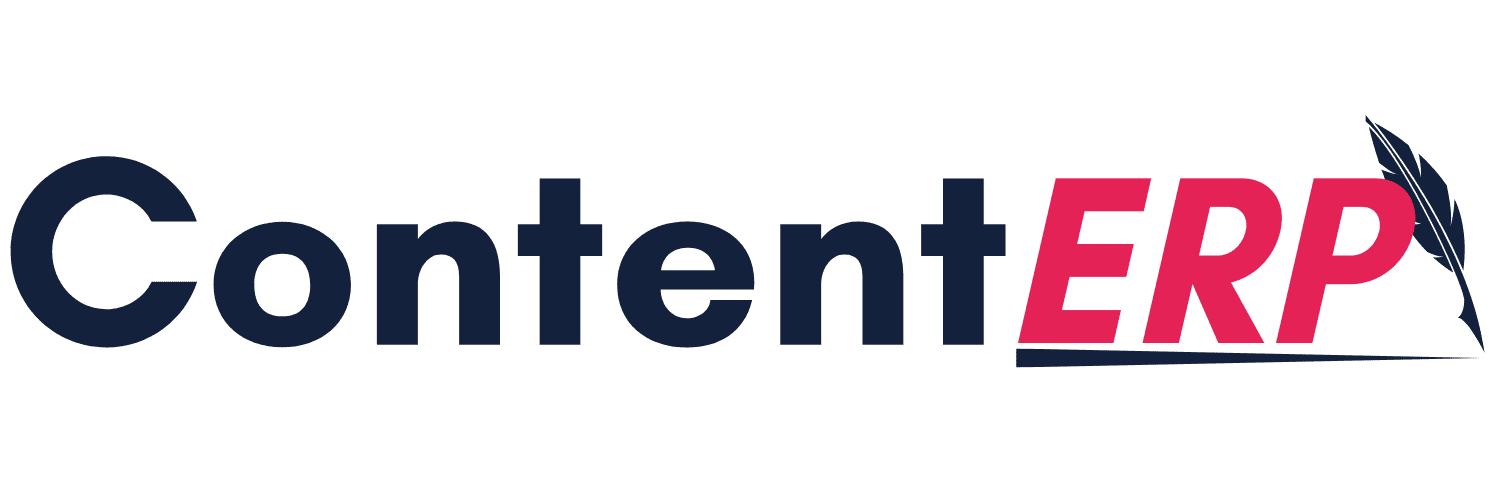by ContentERP | Oct 13, 2024 | Uncategorized
Best Practices for Managing Content Across Multiple Platforms
“Don’t put all your eggs in one basket.” This age-old proverb, usually uttered by cautious investors and meticulous planners, rings especially true in today’s digital landscape. In a world where audiences are as diverse as the platforms they use, focusing your content efforts on a single channel is a gamble few can afford to take. Businesses, creators, and marketers must weave their stories across a tapestry of platforms—each with its unique audience, rules, and expectations. But managing content across multiple platforms is no easy feat. It requires a fine balance between consistency and customization, as well as the right tools to keep everything on track. In this article, we’ll explore the best practices for content management across multiple platforms, using both strategic insights and practical advice.

1. The Multi-Platform Puzzle: Understanding the Challenges
Managing content across various platforms is like orchestrating a symphony. Each instrument—or platform—must play its part, creating a cohesive and harmonious performance. Yet, each platform also demands its unique style and timing. A blog post that works well on LinkedIn may need a complete overhaul to resonate on Instagram or TikTok.
The Problem of Fragmentation: When Content Becomes a Jigsaw Puzzle
One of the main challenges of multi-platform content management is fragmentation. Each platform has its format, tone, and audience behavior. Content that is engaging on might feel out of place on Facebook. Visual-heavy platforms like Instagram or Pinterest require a different approach than text-based platforms like Medium or LinkedIn. Without a unified strategy, it’s easy for your brand’s voice to become fragmented, like pieces of a jigsaw puzzle that don’t quite fit together.
To keep your message coherent, it’s crucial to adapt your content to each platform while maintaining a consistent brand voice. This requires understanding not just the technical requirements but also the cultural nuances of each platform.
2. The Role of Content Management Tools: Your Digital Orchestra Conductor
The key to managing content across multiple platforms is to use the right content management tools. These tools act as the conductors of your digital orchestra, ensuring that every piece of content is published in the right place at the right time.

ContentERP: The Swiss Army Knife of Content Management
One such tool that has gained popularity is ContentERP. It is not just a content management tool; it’s a comprehensive solution for website management systems, social media scheduling, and performance tracking. With ContentERP, you can plan, create, and distribute content from a single platform, reducing the risk of duplication or oversight.
Key Features of ContentERP:
-
Centralized Dashboard: Manage all your content in one place, from blog posts to social media updates. This feature is particularly useful for small teams juggling multiple projects.
-
Cross-Platform Scheduling: Schedule posts for various platforms simultaneously, adjusting content and timing to suit each platform’s unique requirements.
-
Analytics Integration: Track the performance of your content across different platforms, making data-driven adjustments to your strategy.
By using tools like ContentERP, you can streamline your content workflow, ensuring that every piece of content is tailored to its platform without losing sight of the bigger picture.
3. Know Your Platforms: Tailoring Content for Different Audiences
A one-size-fits-all approach rarely works in content marketing. Each platform has its own audience, and understanding these nuances is key to creating content that resonates.

Facebook: The Digital Town Square
Facebook remains the digital town square, ideal for engaging with a broad audience. Content here should be more conversational, with a mix of visuals and text to keep your audience engaged. Remember, Facebook’s algorithm favors content that sparks interaction, so encourage comments, likes, and shares.
Instagram: The Visual Showcase
Instagram is the place for visually striking content. High-quality images, short videos, and Stories are essential. Use Instagram’s features like reels and carousels to showcase your products or tell a compelling story in a visually engaging way.
LinkedIn: The Professional Network
LinkedIn is all about professional development and industry insights. Articles, thought leadership pieces and business updates perform well here. Your content should be more formal and data-driven, targeting professionals looking for value and insights.
X: The Newsroom
X is your brand’s newsroom—a place for quick updates, trending topics, and real-time engagement. Keep your tweets concise and engaging, and use hashtags strategically to reach a broader audience.
YouTube: The Education Hub
If you have the resources, YouTube is perfect for in-depth content like tutorials, product reviews, and webinars. Video content is a powerful tool for building trust and establishing authority in your niche.
Understanding these platform-specific nuances allows you to create content that not only fits but thrives in its digital environment.
4. Streamlining Workflow: The Backbone of Efficient Content Management
Managing content across multiple platforms requires more than just great ideas and creative execution; it demands a well-oiled machine behind the scenes. A streamlined workflow is the backbone of efficient content management.
Create a Content Calendar: Your Tactical Blueprint
A content calendar is more than just a schedule—it’s a tactical blueprint for your content strategy. It helps you plan and visualize your content across platforms, ensuring that you have a consistent posting schedule and a balanced mix of content types.
Best Practices for a Content Calendar:
-
Plan Ahead: Outline your content themes, topics, and formats for the month ahead.
-
Platform-Specific Columns: Use separate columns for each platform to tailor your content more effectively.
-
Flexible Scheduling: Allow room for adjustments to accommodate trending topics or unexpected changes.
Batch Content Creation: Efficiency is Key
Batching is a productivity hack that involves creating multiple pieces of content in one sitting. For example, write all your blog posts for the month in one week, then focus on social media posts the next. This method helps maintain consistency and reduces the cognitive load of constantly switching between tasks.
Automate Routine Tasks: Let the Machines Do the Heavy Lifting
Automation tools are the unsung heroes of content management. They can handle routine tasks like posting, tracking, and reporting, freeing you to focus on strategy and creativity.
Top Automation Tools:
-
Hootsuite or Buffer: For social media scheduling and analytics.
-
Trello or Asana: For project management and workflow organization.
-
Google Analytics: For performance tracking and insights.
Automation doesn’t just save time; it also reduces the risk of human error, ensuring that your content reaches the right audience at the right time.
5. Monitoring and Optimization: The Art of Refinement
Content management isn’t a set-it-and-forget-it affair. Continuous monitoring and optimization are essential to keep your strategy on track.
Track Performance: Numbers Don’t Lie
Use analytics tools to track key performance metrics like engagement rates, click-through rates, and conversion rates. Platforms like Google Analytics and social media insights offer valuable data that can help you refine your strategy.
What to Look For:
-
Engagement: Are people interacting with your content? High engagement indicates that your content is resonating with your audience.
-
Reach: How many people are seeing your content? This helps you understand your brand’s visibility across platforms.
-
Conversion: Is your content driving the desired action, whether it’s signing up for a newsletter or making a purchase?
Adjust and Adapt: The Key to Longevity
The digital landscape is ever-changing, and so should your content strategy. Regularly review your analytics to identify what’s working and what’s not. Be prepared to pivot and try new approaches based on these insights.
“Adapt or Perish” – The Mantra for Digital Success
As Charles Darwin once said, “It is not the strongest of the species that survive, nor the most intelligent, but the one most responsive to change.” In the fast-paced world of digital content, adaptability is the name of the game. Managing content across multiple platforms may seem daunting, but with the right strategy, tools, and mindset, it’s entirely achievable.
So, will you adapt and thrive in this complex digital ecosystem, or will you let the chaos of multi-platform management overwhelm you? With tools like ContentERP and a solid content strategy, you have everything you need to become the maestro of your digital orchestra, conducting your brand’s story across platforms with confidence and finesse. The choice, as always, is yours.
by ContentERP | Oct 13, 2024 | Uncategorized
The Future of Content Creation: AI and Automation

It was the summer of 1939 when an English professor at Harvard, B.F. Skinner, took on an unconventional challenge. Inspired by the booming technological innovations of the time, he built a contraption to help his daughter practice arithmetic. His machine, an early precursor to the teaching aids used today, could present problems and provide immediate feedback—a small but pivotal step toward automating the learning process. Fast forward to today, and we’re witnessing an even more profound transformation: the automation of creativity itself. As we delve into the future of content creation, we find ourselves at the intersection of human ingenuity and machine precision, where artificial intelligence (AI) and automation are poised to redefine how we create and consume content.
From automated writing assistants to AI-driven content management systems, the landscape of content creation is evolving at a dizzying pace. What does this mean for the writers, marketers, and content managers who have long relied on their human touch? Will these technologies enhance our creative capabilities or replace them altogether? This article explores the cutting-edge tools reshaping the industry and offers a glimpse into a future where man and machine collaborate in unprecedented ways.
1. The Rise of AI in Content Creation: From Sci-Fi to Reality
Artificial intelligence in content creation once seemed like the stuff of science fiction—a vision of robots crafting novels or composing music with mechanical precision. Today, it’s no longer a dream but a rapidly advancing reality. AI content generators like GPT-3, developed by OpenAI, can produce coherent and engaging prose, while platforms like ContentBot and Jasper use machine learning algorithms to generate blog posts, social media updates, and even ad copy.
The Tools of the Trade: AI-Powered Content Creation Tools
AI-driven content creation tools are becoming indispensable assets for modern businesses and creatives alike. Here are some of the most noteworthy players:
-
ContentBot: A versatile tool that can generate anything from blog posts to product descriptions. It uses advanced algorithms to understand context and craft content that feels surprisingly human.
-
Copy.ai: Focused on marketing content, Copy.ai offers a range of templates and options for creating everything from catchy slogans to detailed articles, making it an ideal companion for busy marketers.
-
Jarvis (now Jasper): This tool excels in long-form content creation. By inputting a few key points, Jasper can churn out entire articles, saving writers hours of work.
These tools aren’t just automating the grunt work of content creation; they’re changing how we approach the creative process itself. With AI handling the repetitive, formulaic aspects of writing, human creators can focus on higher-level tasks like strategy, storytelling, and innovation.
2. Automation in Content Management: The New Content Ecosystem
If content creation is the raw material of digital communication, content management is the machinery that processes, organizes, and delivers it. Traditionally, content management has been a labor-intensive process, involving numerous tools and platforms to handle tasks like scheduling, SEO optimization, and analytics. But with the advent of AI and automation, this is changing.
Content Creation and Management: A Symbiotic Relationship
Platforms like ContentERP are at the forefront of this revolution, integrating content creation and management into a seamless workflow. By using AI to automate time-consuming tasks such as keyword research, content scheduling, and performance tracking, ContentERP empowers small teams to operate with the efficiency of much larger organizations.
Key Features of AI-Driven Content Management Systems:
-
Automated Scheduling: AI can predict optimal posting times based on audience behavior, ensuring that content reaches its maximum potential.
-
SEO Optimization: Tools like Clearscope and SurferSEO use machine learning to analyze top-ranking content and suggest improvements, from keyword usage to content structure.
-
Performance Analytics: AI can track how content performs across multiple platforms, providing insights that help refine future strategies.
With these tools, content creators can shift their focus from mundane administrative tasks to crafting compelling narratives and strategies that resonate with their audiences.
3. Human Creativity vs. Machine Efficiency: A Harmonious Coexistence?
As AI becomes more adept at creating content, a crucial question arises: what role does human creativity play in a world where machines can generate thousands of words at the click of a button? Is there still a place for the human touch in content creation?
The answer lies in understanding the unique strengths of both humans and machines. AI excels at processing large datasets and identifying patterns—skills that are invaluable for optimizing content for search engines or identifying trending topics. However, it struggles with nuance, context, and emotional resonance—the very qualities that make content truly engaging.
The Creative Symbiosis: Blending AI with Human Insight
Rather than viewing AI as a competitor, content creators can see it as a collaborator. By using AI tools to handle the technical aspects of content creation—like grammar checks, keyword optimization, and structural formatting—writers can focus on the elements that require a distinctly human touch: storytelling, voice, and emotion.
Practical Ways to Blend AI with Human Creativity:
-
Brainstorming: Use AI tools to generate a list of topic ideas, which can then be refined and personalized by human writers.
-
Content Outlines: Let AI draft a basic outline based on SEO best practices, and then build on this framework with your own research and insights.
-
Editing and Proofreading: AI can catch grammatical errors and suggest stylistic improvements, but final edits should always be done by a human to ensure the content’s tone and flow align with your brand.
This collaboration between human intuition and machine efficiency is not about one replacing the other but about enhancing the other’s capabilities.

4. The Future Outlook: Opportunities and Ethical Considerations
As we look to the future, it’s clear that AI and automation will continue to play an increasingly significant role in content creation and management. However, this progress comes with its own set of challenges and ethical considerations.
Opportunities: A New Frontier for Creativity and Efficiency
The possibilities for AI in content creation are vast. Imagine personalized content that adapts in real-time to a user’s preferences, or interactive stories that evolve based on reader input. AI could enable a new era of dynamic, immersive content experiences that blur the lines between creator and audience.
For businesses, the ability to scale content production without sacrificing quality could be a game-changer. Small teams will have the tools to compete with larger organizations, and individual creators will be able to produce professional-grade content at a fraction of the cost.
Challenges: The Ethical Tightrope
With great power comes great responsibility. As AI-generated content becomes more sophisticated, the potential for misuse increases. Issues like plagiarism, misinformation, and the loss of human jobs are real concerns that need to be addressed.
Ethical Questions to Consider:
-
Authenticity: How do we ensure that AI-generated content is transparent about its origins? Should there be a disclaimer when content is created by a machine?
-
Bias: AI models are only as good as the data they’re trained on. How do we prevent these tools from perpetuating biases and stereotypes present in their training data?
-
Job Displacement: As AI takes over more content creation tasks, what happens to the writers, editors, and marketers whose jobs are at risk?
These questions don’t have easy answers, but they are essential to consider as we navigate the rapidly evolving landscape of AI and automation in content creation.
A Brave New World of Content Creation
As we stand on the brink of this brave new world, it’s natural to feel a mix of excitement and apprehension. The integration of AI and automation into content creation is transforming how we work, communicate, and even think about creativity itself. But as Aldous Huxley once said, “Technological progress has merely provided us with more efficient means for going backward.” It’s a reminder that, while technology can enhance our abilities, it’s up to us to use these tools wisely.
Will AI and automation liberate us from the drudgery of repetitive tasks, freeing us to explore new creative frontiers? Or will we lose something essential in the process—our human touch, our unique voice, our ability to connect on a deeply personal level?
by ContentERP | Oct 13, 2024 | Uncategorized
Effective Content Management for Small Teams: How to Do More with Less
In 1941, Winston Churchill delivered one of his most iconic speeches, declaring, “We shall fight on the beaches, we shall fight on the landing grounds, we shall fight in the fields and in the streets, we shall fight in the hills; we shall never surrender.” While the stakes of managing content for a small team are nowhere near as high as Churchill’s, the spirit of resilience and resourcefulness he championed resonates deeply with those who find themselves tasked with juggling multiple roles and responsibilities. In the world of content creation and management, small teams often feel like they are fighting on multiple fronts, with limited resources and an ever-increasing demand for high-quality, engaging material.
So, how do small teams win this battle? How do they manage to create, organize, and publish content effectively without burning out or sacrificing quality? The answer lies in smart strategies, leveraging the right tools, and fostering a culture of collaboration. In this article, we’ll explore practical tips for effective content management for small teams, using a mix of technological aids and human ingenuity.

1. The Power of a Solid Content Management System: Your Arsenal of Tools
For small teams, a robust content management system (CMS) is like a well-stocked arsenal—it provides the necessary tools to plan, create, and distribute content efficiently. One such tool that can be a game-changer is ContentERP, a comprehensive platform designed to streamline the content creation process.
Why Choose ContentERP?
-
Centralized Content Hub: With ContentERP, you can keep all your content, from drafts to published articles, in one place. This helps reduce confusion and ensures everyone is on the same page, quite literally.
-
Collaboration Features: The platform’s collaborative tools make it easier for team members to work together, even if they’re miles apart. You can assign tasks, track progress, and even provide feedback in real-time.
-
Integration Capabilities: ContentERP integrates seamlessly with other tools like Google Analytics and various website builders, allowing you to monitor content performance and make data-driven decisions.
Other CMS options like Squarespace, with its intuitive website builder, can be great for small teams focused on visually appealing web design. The Squarespace login gives users access to an easy-to-use interface where they can manage everything from blogging to e-commerce.
2. Plan, Prioritize, and Repeat: The Strategy of a General
Just as a military general meticulously plans each move, small teams need to have a clear content strategy. Without a well-defined plan, you risk wasting time and resources on content that doesn’t align with your goals or resonate with your audience.
Developing a Content Calendar: Your Battle Map
A content calendar is more than just a schedule; it’s your battle map. It helps you visualize your content strategy, ensuring you’re not only consistent but also relevant.
Tips for Creating an Effective Content Calendar:
-
Set Clear Objectives: Identify what you want each piece of content to achieve. Is it brand awareness, lead generation, or customer engagement?
-
Balance Evergreen and Timely Content: While it’s crucial to stay current, don’t neglect evergreen content that will continue to attract traffic over time.
-
Assign Responsibilities: Clearly define who is responsible for each task. Even in small teams, roles can get blurred, so a clear assignment of duties is essential.
Prioritize Content Efforts: The Art of War
With limited resources, small teams must be strategic about where to focus their efforts. Not every social media post, blog article, or video will have the same impact. Prioritizing high-value content can make all the difference.
How to Prioritize Effectively:
-
Focus on High-Impact Content: Identify which types of content drive the most engagement and conversions. For example, if in-depth blog articles perform better than social media updates, allocate more time to creating those.
-
Leverage Data: Use tools like Google Analytics to track what’s working and what isn’t. Data should guide your decisions, not just gut feelings.
3. Leverage Technology: Your Digital Allies
In the heat of battle, every ally counts. For small content teams, technology can be a powerful ally, automating tedious tasks and allowing human creativity to shine.
Content Creation Tools: Your Digital Scribes
Tools like Grammarly for proofreading or Canva for design can save precious time, ensuring your content is polished and professional.
Top Tools for Small Teams:
-
ContentERP: Beyond its CMS capabilities, ContentERP offers advanced content analytics and SEO tools, making it easier to optimize your content for search engines.
-
Trello or Asana: These project management tools help you keep track of tasks, deadlines, and workflows. They’re particularly useful for visualizing your content calendar and ensuring nothing slips through the cracks.
-
Google Drive: For easy document sharing and real-time collaboration, Google Drive is an indispensable tool for small teams.
Automation: Your Secret Weapon
Automation tools can handle repetitive tasks like social media posting or email marketing, freeing up your team to focus on more strategic initiatives.
Examples of Automation Tools:
-
Hootsuite: Schedule and manage social media posts across multiple platforms from a single dashboard.
-
Mailchimp: Automate your email marketing campaigns, segment your audience, and track performance, all without lifting a finger.
4. Foster a Culture of Collaboration: The Bond of the Band of Brothers

In any team, large or small, collaboration is key to success. But for small teams, where each member often wears multiple hats, it’s even more critical. Building a culture of open communication and mutual support can significantly boost productivity and morale.
Encourage Open Communication: The Lifeblood of the Team
Just as soldiers in the trenches must communicate effectively to coordinate their actions, your team needs a clear line of communication.
Tips for Effective Communication:
-
Regular Check-ins: Schedule short, regular meetings to discuss ongoing projects, roadblocks, and new ideas.
-
Use Collaborative Tools: Platforms like Slack or Microsoft Teams can facilitate quick communication and reduce the need for lengthy email threads.
-
Be Open to Feedback: Encourage team members to share their thoughts and ideas. Often, the best solutions come from unexpected places.
5. Review and Reflect: The Debrief After the Battle
Once you’ve executed your content strategy, it’s crucial to review what worked and what didn’t. Like a general reviewing the outcomes of a battle, your team should regularly assess your content performance and strategy.
Analyze Performance Metrics: The Post-Mortem Report
Using tools like Google Analytics, you can gain insights into how your content is performing. Look at metrics like page views, bounce rate, and conversion rates to determine which pieces resonated with your audience.
How to Use This Data:
-
Identify Strengths and Weaknesses: What types of content performed best? What didn’t work as well as expected? Use this information to refine your strategy.
-
Adjust Your Plan: Based on your analysis, make adjustments to your content calendar, topics, or formats. Remember, content strategy is an ongoing process, not a set-it-and-forget-it task.
Will You Be the Hero of Your Story?
Managing content for a small team is no easy feat—it’s a balancing act of creativity, strategy, and technology. But with the right tools and mindset, you can turn even the smallest team into a content powerhouse. As small teams continue to fight their battles in the vast digital landscape, the question remains: Will you be the hero of your story, or will you let the challenges overwhelm you?
“Success is not final, failure is not fatal: it is the courage to continue that counts,” said Winston Churchill. For small teams managing content, these words ring especially true. The journey may be long and the obstacles many, but with courage, resilience, and a little help from the right tools, victory is within reach.
by ContentERP | Oct 13, 2024 | Uncategorized
How to Use Keyword Research Tools to Improve SEO
An old saying goes, “You can lead a horse to water, but you can’t make it drink.” In the digital world, the water is your website content, and the horse represents your audience. While great content is essential, it won’t matter if your audience can’t find it. This is where keyword research comes into play—it’s like placing signposts along a winding trail, guiding thirsty horses straight to your water source. But to craft those signposts effectively, you need the right tools and strategies.
Keyword research is more than just finding popular words and phrases; it’s about understanding your audience’s language and aligning your content with their needs. When done correctly, it is the cornerstone of effective search engine optimization (SEO), helping you attract the right traffic and, ultimately, drive more conversions. In this article, we’ll explore how to use keyword research tools to improve your SEO strategy, with insights and practical tips for getting the most out of your efforts.

1. The Importance of Keyword Research in SEO: The Compass to Guide Your Strategy
Think of keyword research as a compass for your SEO strategy. As a sailor wouldn’t venture into uncharted waters without navigation tools, no content creator should embark on SEO without thorough keyword research. It’s the process of discovering the terms and phrases people use when searching for information online, and it’s critical for several reasons:
Why It Matters:
-
Targeted Traffic: By understanding what your audience is searching for, you can create content that directly addresses their queries, attracting more relevant visitors to your site.
-
Improved Visibility: Using the right keywords helps your content appear in search engine results pages (SERPs), making it easier for potential customers to find you.
-
Content Strategy Foundation: Keywords inform the topics you cover, ensuring your content is both engaging and valuable.
2. Getting Started: Tools to Navigate the Keyword Research Landscape
Before diving into the depths of keyword research, it’s essential to have the right tools in your toolkit. There are several powerful options available, each offering unique insights into keyword performance, competition, and search trends. Let’s take a closer look at some of the best tools:
Content ERP: Your All-in-One SEO Companion
Content ERP is more than just a content management platform—it’s a comprehensive SEO tool that simplifies keyword research, content creation, and performance tracking. With its intuitive interface, you can easily identify high-performing keywords, track your rankings, and refine your strategy over time.
How to Use It:
-
Keyword Discovery: Use the keyword research feature to find relevant keywords based on your niche. Content ERP’s AI-driven suggestions help you uncover opportunities you might otherwise miss.
-
Content Optimization: Leverage the on-page SEO recommendations to optimize your content for the selected keywords, ensuring it ranks higher on SERPs.
Ahrefs Keyword Generator: The Data-Driven Powerhouse
Ahrefs is renowned for its robust keyword research capabilities. The Ahrefs Keyword Generator provides an in-depth analysis of keyword difficulty, search volume, and click-through rates, making it easier to prioritize which keywords to target.
How to Use It:
-
Keyword Difficulty Analysis: Use Ahrefs to identify keywords that are within your reach. Focus on terms with moderate difficulty and high search volume to maximize your chances of ranking.
-
Competitor Research: Enter your competitor’s URL to discover which keywords they’re ranking for. This can help you identify content gaps and opportunities to outperform them.
Google Analytics: The Insightful Oracle
While not a keyword research tool per se, Google Analytics offers invaluable insights into how your existing content is performing. By analyzing metrics like bounce rate, session duration, and page views, you can identify which keywords are driving traffic and where there’s room for improvement.
How to Use It:
-
Audience Insights: Analyze the keywords your visitors are using to find your site. This data helps you understand what resonates with your audience and where to focus your efforts.
-
Content Performance: Use the behavior reports to see which pages are performing well and which need optimization. Adjust your content strategy based on these insights.
3. Crafting Your Keyword Strategy: The Blueprint for Success
Once you’ve gathered data from your keyword research tools, it’s time to craft a strategy that aligns with your business goals. This involves selecting the right keywords, organizing them into clusters, and creating content that not only targets those keywords but also provides genuine value to your audience.
Select Your Keywords Wisely: Balancing Competition and Relevance
Choosing the right keywords is like picking fruit from a tree. You want the ripest, juiciest ones—those with high search volume and low competition. However, it’s not just about choosing the most popular terms; you need to find keywords that are relevant to your business and audience.
Tips for Choosing Keywords:
-
Focus on Long-Tail Keywords: These are more specific phrases, often containing three or more words, like “best keyword research tools for small businesses.” They may have a lower search volume but are easier to rank for and attract more qualified traffic.
-
Check Search Intent: Make sure the keywords you choose align with the intent behind your content. Are users looking for information, making a purchase decision, or seeking a solution to a problem? Tailor your content to match these intentions.
Organize Keywords into Clusters: The Content Map
Think of your keywords as puzzle pieces. To create a clear picture, you need to group related keywords. This is known as keyword clustering and helps you structure your content in a way that improves SEO and user experience.
How to Do It:
-
Create Topic Clusters: Group keywords into themes or topics. For example, if your focus is on “SEO tools,” you might have clusters for “best SEO tools,” “free SEO tools,” and “how to choose SEO tools.”
-
Plan Content Around Clusters: For each cluster, create a pillar page that covers the main topic comprehensively, supported by sub-pages that delve into related subtopics. This approach not only improves internal linking but also establishes your site as an authority on the topic.
4. Creating SEO-Optimized Content: Turning Keywords into Compelling Narratives
Keywords are the seeds of your content, but it’s your job to nurture them into flourishing narratives. Creating SEO-optimized content is about more than just sprinkling keywords throughout an article—it’s about crafting engaging, valuable content that resonates with your audience.
Incorporate Keywords Naturally: The Art of Seamless Integration
Using keywords effectively is like seasoning a dish—you want to enhance the flavor without overwhelming the palate. The same goes for content: keywords should fit naturally into the flow of your text.
Tips for Natural Integration:
-
Use Keywords in Key Places: Include your primary keyword in the title, first paragraph, headers, and meta description. Use secondary keywords throughout the body text.
-
Avoid Keyword Stuffing: Don’t force keywords where they don’t belong. This not only disrupts the readability of your content but can also result in search engine penalties.
-
Vary Your Language: Use synonyms and related terms to maintain a natural flow and avoid repetition. For example, if your primary keyword is “keyword research,” you could also use phrases like “finding keywords” or “keyword analysis.”
Create High-Quality, Engaging Content: The Heart of SEO
Great SEO content is like a good book—it keeps readers engaged from start to finish. While keywords help search engines find your content, it’s the quality and relevance of that content that keep readers on the page.
Content Creation Tips:
-
Focus on User Experience: Ensure your content is easy to read, visually appealing, and accessible. Use headers, bullet points, and images to break up text and improve readability.
-
Provide Value: Address your audience’s needs, answer their questions, and offer actionable insights. The more value you provide, the more likely readers are to share your content and return to your site.
-
Tell a Story: People remember stories, not statistics. Weave narratives into your content to illustrate points and make your message more relatable and memorable.
5. Measuring and Refining Your Strategy: The Continuous Journey of SEO Improvement
SEO is not a one-and-done task—it’s an ongoing process of refinement and adaptation. After implementing your keyword strategy and creating content, it’s crucial to measure its performance and adjust your approach as needed.

Use Analytics to Track Success: The Feedback Loop
Analytics are your compass in the ever-changing landscape of SEO. By monitoring key metrics, you can see what’s working, what’s not, and where there’s room for improvement.
Key Metrics to Monitor:
-
Organic Traffic: The number of visitors coming to your site from search engines. Increasing organic traffic is a good indicator that your SEO strategy is working.
-
Bounce Rate: The percentage of visitors who leave your site after viewing only one page. A high bounce rate may indicate that your content isn’t meeting user expectations.
-
Conversion Rate: The percentage of visitors who complete a desired action, such as signing up for a newsletter or making a purchase. This metric helps you gauge the effectiveness of your content in driving business goals.
Refine Your Strategy: The Art of Adaptation
SEO is a dynamic field, with search engine algorithms and user behaviors constantly evolving. Regularly revisiting your keyword strategy and content performance is essential to stay ahead of the curve.
Tips for Refinement:
-
Update Old Content: Refreshing outdated content with new information and optimized keywords can significantly boost its performance.
-
Experiment with New Keywords: Use tools like the Ahrefs Keyword Generator to explore new keyword opportunities and expand your content reach.
-
Test and Learn: SEO is as much about experimentation as it is about strategy. Try different approaches, and track the results.
by ContentERP | Oct 13, 2024 | Uncategorized
Top Tips for Publishing SEO-Optimized Content on Schedule

In a small Italian village perched on a hillside, there once lived a clockmaker named Enzo. His craft was renowned far and wide, not just because his clocks were beautifully intricate, but because they were uncannily precise. Every chime, every tick, every tock was a testament to his meticulous attention to detail and unwavering commitment to punctuality. It is said that Enzo could set his clocks to match the sunrise and sunset with a precision so exact, it seemed as if he had time itself dancing to his tune.
For content creators and digital marketers today, the challenge is not unlike Enzo’s: to craft each piece with precision, ensuring it is delivered exactly on schedule, and that it resonates perfectly with the intended audience. But in the bustling, fast-paced world of digital marketing, the clock never stops ticking, and delivering SEO-optimized content on time can feel like chasing after a runaway train.
Yet, just as Enzo mastered the art of timekeeping, so too can you master the art of publishing SEO-optimized content on schedule. It requires a blend of strategy, discipline, and the right tools—tools like ContentERP that help keep the gears of your content engine well-oiled and running smoothly. In this article, we’ll explore top tips to help you stay on track, craft compelling SEO content, and keep your readers—and the search engines—coming back for more.
1. Plan Ahead: The Content Calendar is Your Blueprint
Like a master architect, your first step in creating a beautiful, functioning structure is drafting a blueprint. In the world of content, this blueprint is your content calendar. It’s the cornerstone of successful content creation and publishing, offering a bird’s-eye view of your content strategy for weeks or even months ahead.

Why It Matters: A well-organized content calendar helps you visualize your upcoming content pieces, align them with important dates (like product launches or seasonal trends), and ensure that you’re not scrambling to come up with ideas at the last minute. This foresight allows for more thoughtful, strategic content planning.
How to Do It: Utilize tools like ContentERP to create a dynamic content calendar. Assign topics, set deadlines, and track the progress of each piece of content. Remember to include buffer time for revisions and unexpected delays. A good rule of thumb is to schedule high-priority content a week or two in advance, leaving room for spontaneity and trend-responsive posts.
2. Keyword Research: The North Star of SEO Content Writing
Imagine setting sail without a compass—terrifying, right? Similarly, creating content without proper keyword research is like navigating the digital seas without direction. Keywords are the foundation of search engine optimization; they are the signals that guide search engines to your content.

Why It Matters: Effective keyword research ensures that your content is aligned with what your audience is searching for. It helps you understand the language they use, the questions they’re asking, and the problems they’re looking to solve. This is crucial for attracting organic traffic and establishing your authority in your niche.
How to Do It: Use SEO tools like Google Keyword Planner, Ahrefs, or the integrated SEO tool in ContentERP. Start by identifying a broad topic relevant to your niche, then narrow it down using long-tail keywords—these are often less competitive and more specific. For example, instead of targeting “SEO tools,” aim for “best SEO tools for small businesses.” This focus will help your content stand out in a crowded digital landscape.
3. Create Content Briefs: The Recipe for Success
Imagine trying to bake a complex dessert without a recipe—what you’d get is a kitchen disaster rather than a culinary masterpiece. Similarly, jumping into content creation without a clear brief can lead to disorganized, unfocused articles that fail to meet your goals.
Why It Matters: A content brief is a detailed outline that guides the writer on the scope, structure, and style of the article. It should include the target keyword, audience personas, key points to cover, and any specific calls to action. This ensures that everyone involved in the content creation process is on the same page and that the final product is cohesive and impactful.
How to Do It: Use ContentERP to create comprehensive content briefs. Include information on the target audience, the primary and secondary keywords, and the key messages you want to convey. If you’re working with a team, these briefs can be shared and edited collaboratively, ensuring everyone’s input is integrated into the final piece.
4. Optimize as You Write: Weaving SEO into the Fabric of Your Content
Think of SEO like the threads that weave through the fabric of your content. It shouldn’t be an afterthought or an add-on; rather, it should be part of the content creation process from the beginning. This means optimizing your content as you write, not after it’s completed.
Why It Matters: When SEO is integrated into the writing process, it creates content that is naturally optimized for search engines and readers alike. This includes using the primary keyword in strategic places, such as the title, headers, and throughout the body text, as well as optimizing meta descriptions and image alt text.
How to Do It: Tools like ContentERP’s SEO writing assistant can be invaluable here. As you write, it provides real-time feedback on keyword usage, readability, and SEO best practices, helping you fine-tune your content for maximum impact. Remember, good SEO content is not just about keyword stuffing; it’s about creating value for the reader while adhering to search engine guidelines.
5. Stick to a Publishing Schedule: Consistency is King
Consistency is the heartbeat of a successful content strategy. Imagine your favorite newspaper suddenly publishing sporadically—you’d quickly lose trust and interest. The same applies to your content. A predictable publishing schedule keeps your audience engaged and signals to search engines that your site is active and relevant.
Why It Matters: Regularly publishing high-quality content builds credibility with both your audience and search engines. It also helps you stay top-of-mind with readers, increasing the likelihood of them returning to your site.
How to Do It: Determine a realistic publishing schedule based on your resources and stick to it. Whether it’s once a week or three times a month, consistency is more important than frequency. Use scheduling features in ContentERP to automate the publishing process, ensuring that your content goes live exactly when you want it to.
6. Use Analytics to Refine Your Strategy: Learn, Adapt, Improve
Imagine planting a garden but never checking to see which plants are thriving and which are wilting. Without feedback, you’d never know what’s working. The same is true for your content strategy. Analytics provide the insights you need to refine your approach, ensuring your efforts are yielding the best possible results.
Why It Matters: Data-driven decision-making is the cornerstone of successful content marketing. By analyzing metrics such as page views, time on page, and conversion rates, you can identify what resonates with your audience and what falls flat.
How to Do It: Use analytics tools like Google Analytics or the built-in analytics dashboard in ContentERP to monitor your content performance. Pay attention to metrics like organic traffic, bounce rate, and engagement. Use this data to tweak your strategy, optimize underperforming content, and double down on what’s working.
7. Embrace Automation: Work Smarter, Not Harder
Automation is the secret weapon of modern marketers, akin to having a digital assistant that never sleeps. From scheduling social media posts to sending out email campaigns, automation tools can save you time and reduce the risk of human error.
Why It Matters: Automating repetitive tasks frees up your time to focus on higher-level strategy and creative work. It also ensures that your content is published and promoted consistently, even when you’re not at your desk.
How to Do It: Use tools like ContentERP to automate your content scheduling and distribution. You can set up workflows that automatically publish content, distribute it to social media channels, and even send it out in email newsletters. This not only keeps your content calendar on track but also ensures your audience is regularly engaged.
8. Maintain Quality Under Pressure: Prioritize Craft Over Quantity
In the race to publish content on schedule, it’s easy to prioritize speed over quality. But remember, publishing a high volume of mediocre content is like scattering seeds on barren soil—it might look busy, but it won’t yield results.
Why It Matters: Search engines and readers alike favor quality over quantity. Well-researched, well-written, and well-optimized content is far more likely to rank highly and attract loyal readers than a flood of subpar articles.
How to Do It: Set clear quality standards for your content, regardless of deadlines. This might mean fewer, but better, pieces. Use ContentERP to streamline the editing process and ensure that every piece of content meets your standards before it goes live. Remember, your brand’s reputation is on the line with every piece you publish.

Timing is Everything
Just like Enzo the clockmaker, your success in content creation depends on a delicate balance of precision, timing, and craftsmanship. By planning ahead, leveraging SEO tools, and maintaining a commitment to quality, you can publish SEO-optimized content that not only meets deadlines but exceeds expectations.
In the words of Benjamin Franklin, “By failing to prepare, you are preparing to fail.” Take the time to plan, optimize, and refine your content strategy, and you’ll find that publishing on schedule isn’t a race against time—it’s a well-choreographed dance.
Call to Action:
Ready to master the art of timely, SEO-optimized content creation? Sign up on ContentERP today and discover how our tools can help you plan, create, and publish content that keeps your audience—and the search engines—coming back for more. After all, why let time control you when you can master it?
by ContentERP | Oct 13, 2024 | Uncategorized
How to Integrate AI into Your Content Creation Process
Imagine, for a moment, an artist standing before a blank canvas. Their brushes are poised, colors ready, but there’s something different about this scene. Instead of the artist painstakingly mixing colors and sketching outlines, there’s a new collaborator in the studio: a machine that suggests brush strokes, offers color combinations, and even fills in the details with uncanny precision. This isn’t a glimpse into a sci-fi future—it’s the present reality of AI in content creation.
As we stand on the brink of a new digital renaissance, the question for content creators is not whether to integrate artificial intelligence into their workflows, but how. AI, once viewed as a futuristic concept, has now firmly embedded itself in the fabric of our daily lives. From virtual assistants like Siri to Netflix recommendations, AI is no longer a novelty. And in the realm of content creation, it’s becoming a transformative force, turning tedious processes into seamless, creative endeavors.

The New Co-Author: AI’s Role in Content Creation
Can a machine really help you write a compelling blog post, craft an engaging social media campaign, or design a visually stunning infographic? The answer is a resounding yes. AI writing tools, such as the AI writer offered by platforms like Content ERP, are not here to replace human creativity but to enhance it—like a well-trained sous-chef in a bustling kitchen.
Imagine this: You have a deadline looming, and the blank page is staring back at you like a taunting void. Instead of the usual battle between inspiration and procrastination, you turn to an AI writer. With a few prompts, it generates a draft—structured, coherent, and brimming with ideas. It’s not perfect, but it’s a starting point. You take the draft and shape it, adding your unique voice and perspective. The result is a seamless blend of human creativity and machine efficiency, a dance between mind and algorithm.
Leveraging AI for Textual Brilliance
AI writing tools have evolved far beyond basic spell-check and grammar suggestions. Today, they can help brainstorm topics, outline articles, generate content drafts, and even optimize text for SEO. Let’s break down a few ways you can use AI to elevate your writing process:

-
Brainstorming and Ideation: Struggling to come up with fresh content ideas? AI-powered tools can analyze trending topics, popular keywords, and audience preferences to suggest relevant themes and titles. This is like having a brainstorming session with a hyper-intelligent assistant who never tires.
-
Draft Generation: Whether you need a product description, a blog post, or an entire eBook, AI writers can produce well-structured drafts in minutes. You provide the topic and parameters, and the AI does the heavy lifting. It’s like hiring a ghostwriter who never sleeps.
-
SEO Optimization: Search engine algorithms are perpetually evolving, and keeping up can feel like trying to hit a moving target. AI tools like Content ERP’s integrated SEO optimizer can analyze your content for keyword usage, readability, and other factors, ensuring your content ranks highly on search engine results pages (SERPs).
-
Content Personalization: AI can analyze user data to help you create personalized content that resonates with specific audience segments. Imagine knowing exactly what your readers are interested in and tailoring your content to meet their needs—this is the power of AI-driven personalization.
The Visual Revolution: AI and Imagery
Words are powerful, but in the digital age, visuals often steal the spotlight. Enter AI image generators—the best of which can turn text prompts into striking visuals, saving time and money while unleashing new creative possibilities. Need an image of a futuristic cityscape for your sci-fi article? Or perhaps a whimsical illustration for a children’s story? AI can generate these with a few keystrokes.
Using the best AI image generator tools, you can create custom graphics, infographics, and even digital art that complements your written content. These visuals are not just placeholders; they are integral parts of storytelling that can captivate your audience, enhance understanding, and boost engagement. The result? A richer, more immersive experience for your readers.

Integrating AI into Your Workflow: A Step-by-Step Guide
So, how do you go about integrating AI into your content creation process? Here’s a roadmap to get you started:
-
Identify Your Needs: Assess which parts of your content creation process are most time-consuming or challenging. Are you struggling with ideation? Drafting? Visual content? Pinpointing your pain points will help you choose the right AI tools.
-
Choose the Right Tools: Platforms like Content ERP offer a range of AI-driven tools tailored to different aspects of content creation. Whether you need an AI writer for text generation or the best AI image generator for visuals, there’s a tool designed to meet your needs.
-
Experiment and Iterate: Start small—use AI to generate ideas or outlines. As you become more comfortable, expand its role in your workflow. Remember, AI is a tool, not a crutch. Use it to enhance your creativity, not replace it.
-
Evaluate and Optimize: Regularly assess the performance of AI-generated content. Use analytics to track engagement and adjust your approach as needed. The more you refine your process, the better the results.
The Future of Creativity: A Symbiotic Relationship
As AI continues to evolve, so too will its role in content creation. Far from being a threat, it offers unprecedented opportunities for creators to push the boundaries of what’s possible. Imagine a world where your creative ideas are no longer limited by time or resources, where the process of bringing them to life is as exhilarating as the ideas themselves.
Picture this: It’s late at night. You’re sitting at your desk, the glow of the screen illuminating your face. You type a few words, and the AI responds, suggesting phrases, conjuring images. It’s almost as if the machine can sense your thoughts, translating them into text and visuals in real-time. There’s a hum of excitement in the air, a sense that anything is possible. You’re not just creating—you’re co-creating, in a seamless blend of human intuition and machine precision.
So, as you embark on your next content project, ask yourself: What could you achieve with an AI partner by your side? With platforms like Content ERP, the possibilities are endless. Whether you’re crafting compelling narratives or stunning visuals, AI can help you elevate your work to new heights. Ready to take your content creation to the next level? Sign up on Content ERP today and discover how AI can revolutionize your creative process. After all, why paint with one brush when you can wield a thousand?
